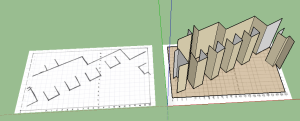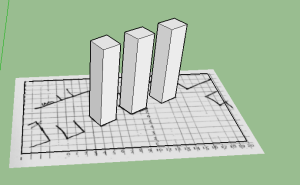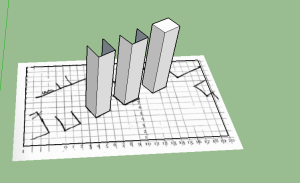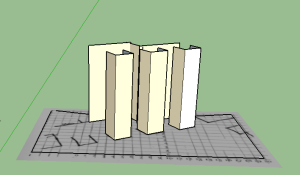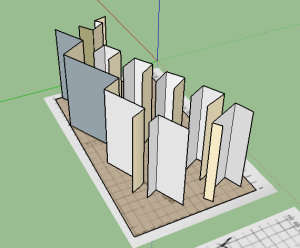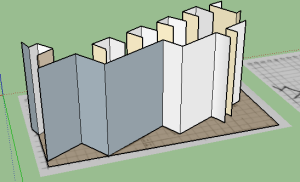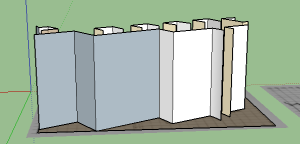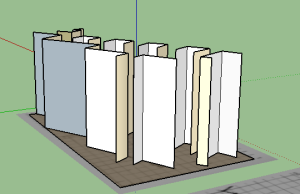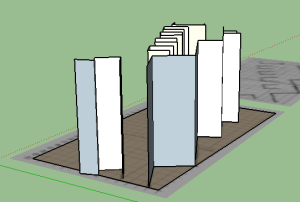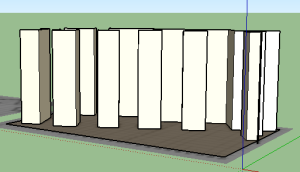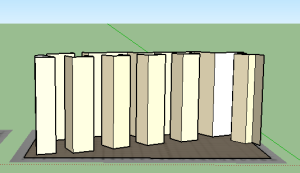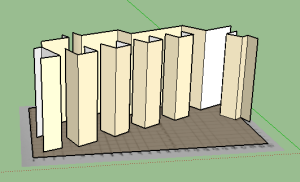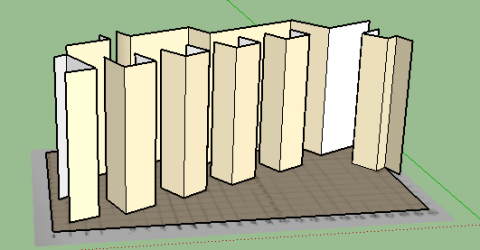
The Hour-Glass is of course the main focus of our project. In order to create a sort of holistic view of the use of Craig’s screens in the old Abbey, it was suggested by classmate Freya that I create a model of another play that was staged there – The Deliverer by Lady Gregory. This was chosen because it was one of the first plays that the screens were used in (the other one being The Hour-Glass; see Flannery). Another reason why this was selected is because a sketch by Yeats of the stage design survives, and this is the primary source that I used for my model. In the sketch we see the same basic grid layout that he uses in the sketch for The Hour-Glass (read more here) again, with a simple sketch of the screens drawn over it.
This review of The Deliverer from the Irish Times in 1911 provides some context for the play:
“There is in the first place a reduction of the stage furniture to its simplest elements, so that the figures of the play stand out more prominently against the primitive background and attention is concentrated on the hum and truly expressive elements of the drama. There is next a careful design and adjustment of the simplest elements of staging which still further tends to secure the effect. Lastly, there is similar elements of staging which still further tends to secure that effect. Lastly, there is a similar care in regard to the supplementary elements – lighting arrangements and costuming […] The success of these aims is a result of the genius of an individual producer, who combines with artistic and thoughtful ideas on the principles of staging, an unusual ability to deal with the mechanical problems involved in giving effect to those principles.” (The Irish Times, 13 January 1911)
The intention of this visualisation is to provide an interpretation of what the stage design might have looked. It is of course based on a real sketch, but is a hypothetical recreation. It was not the intention to create a particularly sophisticated visualistaion, but rather an adequate representation with enough detail to inspire our audience to imagine the screens being used in another play. The 3D Model can be downloaded by users if they work with it themselves.
So how did I create my model? Sketch Up is our tool of choice for our modelling. It’s a free tool which is easy to use and it doesn’t take too long to become fairly competent using it. You can read about our decision to use SketchUp here. I started by importing an image of the stage design into SktechUp. Full credit goes to my classmate Michael for finding the Miller book (a really useful source of images and commentary; scroll to the bottom of this post for bibliography) and scanning the images as standalone items to our Google Drive. I was able to download the below an image of Miller’s sketch of Yeats’s stage and sketch it myself. I then uploaded the image and imported it to SketchUp:
Having such a detailed grid pattern made this image nice to work with. I was able to trace over the image and create a crude outline of each shape. To create a 3D effect, I turned each line into a rectangle or triangle and then used the push-pull tool to move each screen up. The lack of detailed measurements in this sketch was definitely a challenge. I pulled each shape up to a height of 15’ (remember each screen is modelled to this height based on evidence that the top of the screens would not have been visible to the audience – you can read more about this Laura’s post ).
Then I erased the unnecessary edges to create the 3D hollow screens. This was a relatively straightforward way to make each screen. Note: For the four stand alone pillars which dominate the stage, I could have simply created on and copied it three times to create all four pillars, but instead I tried to be as true to the original sketch as possible and traced over the outline of each one. Similarly, in the sketch some of the lines stray out over the actual stage area. An argument could be made for the removal of these (or more perhaps more correctly for omitting them from the model) but again, I tried to replicate the image as accurately as possible so I left them in. There was a small bit of ambiguity in terms of the layout of the screens at the back of the stage in that required some careful consideration. I determined that the most likely set up was to disregard one of the lines in the sketch and create two discrete sections, providing an entrance for actors upstage.
Deciding on a colour for the screens in my model was easy. A number of sources refer to Craig’s ivory-coloured screens (read more here), so I coloured the screens ivory. In terms of texture, there are a limited number of references to the texture of the screens. Flannery cites the following response from Craig to Yeats regarding texture:
As to the surface of a screen I like best the natural surface if it is distinguished enough – A silk yes – or when the screens are made oak – yes – (Bronze we shall see in time). But meantime, I don’t much like the natural canvas surface. I should propose something more frankly artificial than paint (which however you may still find suits you best)[…] Craig to Yeats quoted in Flannery
Given the emphasis Craig places on light in much of his writing, I felt that silk would be a good option. After some testing an imported texture of silk proved ineffective. So I decided to opt for the out of the box texture option in SketchUp.
Finally I coloured in the floor of the stage and turned down the opacity to make the underlying sketch visible. The images below give an overview of the finished model from a selection of different angles.
- Back Right corner
- Front Straight On
- Front From Height
- 3D Model of Yeats’s stage design for The Deliverer featuring Gordon Craig’s Screens
Bibliography:
- Miller, Liam, and Dolmen Press. The Noble Drama of W. B. Yeats. Dublin: Dolmen Press, 1977. Print
- Flannery, James W. ‘W.B Yeats, Gordon Craig and the Visual Arts of the Theatre’. Yeats and the Theatre. Ed. O’Driscoll, Robert and Reynolds, Lorna. London [etc.]: Macmillan, 1975. 82–108. Print.

